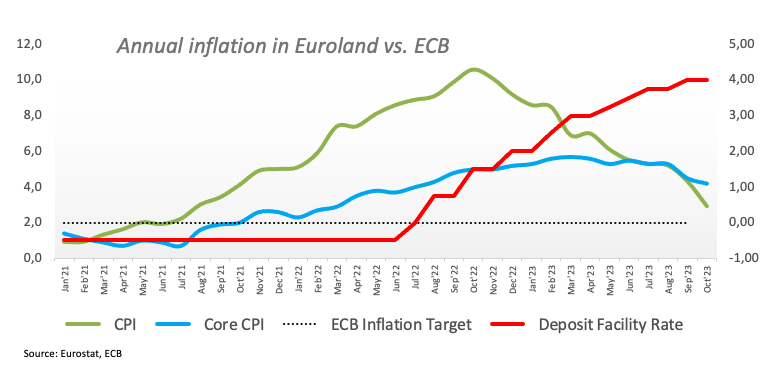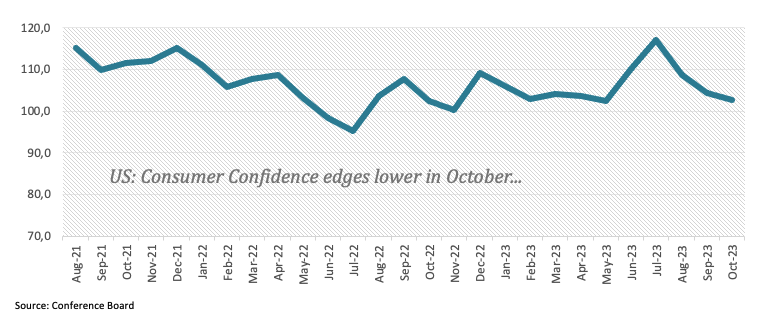- The Euro comes under marked downside pressure against the US Dollar.
- European stocks cling to daily gains across the board on Tuesday.
- The US Consumer Confidence came in above estimates in October.
The Euro (EUR) gives away the initial strength against the US Dollar (USD), forcing EUR/USD to give away the earlier advance to five-day highs in the proximity of 1.0675 and shift its focus to the 1.0600 support once again.
On the other side of the equation, the Greenback manages to regain composure following a brief dip to the sub-106.00 zone when measured by the USD Index (DXY). The change of direction in the Greenback comes in tandem with some recovery in US yields across different timeframes, particularly in respone to the better-than-expected Consumer Confidence figures.
In the context of monetary policy, there is a growing agreement among market participants that the Federal Reserve (Fed) is likely to maintain its current position of keeping interest rates unchanged at Wednesday's meeting. Nonetheless, there is a possibility of a rate adjustment in December, which appears to be supported by the continued strength of the US economy and still-high inflation levels.
In the domestic calendar, Retail Sales in Germany contracted 4.3% in the year to September. In the broader Eurozone, advanced Inflation Rate for October saw the CPI rising 2.9% YoY, while flash Q3 Gross Domestic Product (GDP) Growth Rate expect the economy to contract 0.1% QoQ and expand 0.1% YoY.
In the US data space, the Employment Cost - Benefits expanded 0.9% QoQ in Q3 and Employment Cost - Wages rose 1.2% QoQ. In addition, the FHFA House Price Index increased by 0.6% MoM in August and the key Consumer Confidence measured by the Conference Board surpassed expectations at 102.6 for the current month.
Daily digest market movers: Euro's upside remains capped by 1.0700
- The EUR trades with marked losses against the USD.
- US and German yields trade mostly on the defensive.
- The Fed could still hike rates by 25 bps in December.
- The ECB is expected to maintain its monetary policy impasse until H2 2024.
- Geopolitical concerns in the Middle East remain unabated.
- The BoJ tweaked its YCC programme at its meeting earlier on Tuesday.
- Chinese PMIs surprised to the downside in October.
- There is rising market chatter suggesting further stimulus by the PBoC.
Technical Analysis: Euro could still challenge 1.0500
Next on the upside for EUR/USD comes the interim 55-day Simple Moving Average (SMA) at 1.0669 prior to the October peak of 1.0694 (October 24). The breakout of this level exposes the weekly top of 1.0767 (September 12) ahead of the crucial 200-day SMA at 1.0809, while another weekly high of 1.0945 (August 30) comes before the psychological barrier of 1.1000. Beyond this region, the pair may encounter resistance at the August peak of 1.1064 (August 10), ahead of the weekly top of 1.1149 (July 27) and the 2023 high of 1.1275 (July 18).
The resumption of the bearish mood could drag the pair to the weekly low of 1.0495 (October 13), ahead of the lowest level in 2023 at 1.0448 (October 15), and the round number of 1.0400.
The pair's outlook is predicted to continue bearish as long as it remains below the crucial 200-day SMA.
Euro FAQs
What is the Euro?
The Euro is the currency for the 20 European Union countries that belong to the Eurozone. It is the second most heavily traded currency in the world behind the US Dollar. In 2022, it accounted for 31% of all foreign exchange transactions, with an average daily turnover of over $2.2 trillion a day.
EUR/USD is the most heavily traded currency pair in the world, accounting for an estimated 30% off all transactions, followed by EUR/JPY (4%), EUR/GBP (3%) and EUR/AUD (2%).
What is the ECB and how does it impact the Euro?
The European Central Bank (ECB) in Frankfurt, Germany, is the reserve bank for the Eurozone. The ECB sets interest rates and manages monetary policy.
The ECB’s primary mandate is to maintain price stability, which means either controlling inflation or stimulating growth. Its primary tool is the raising or lowering of interest rates. Relatively high interest rates – or the expectation of higher rates – will usually benefit the Euro and vice versa.
The ECB Governing Council makes monetary policy decisions at meetings held eight times a year. Decisions are made by heads of the Eurozone national banks and six permanent members, including the President of the ECB, Christine Lagarde.
How does inflation data impact the value of the Euro?
Eurozone inflation data, measured by the Harmonized Index of Consumer Prices (HICP), is an important econometric for the Euro. If inflation rises more than expected, especially if above the ECB’s 2% target, it obliges the ECB to raise interest rates to bring it back under control.
Relatively high interest rates compared to its counterparts will usually benefit the Euro, as it makes the region more attractive as a place for global investors to park their money.
How does economic data influence the value of the Euro?
Data releases gauge the health of the economy and can impact on the Euro. Indicators such as GDP, Manufacturing and Services PMIs, employment, and consumer sentiment surveys can all influence the direction of the single currency.
A strong economy is good for the Euro. Not only does it attract more foreign investment but it may encourage the ECB to put up interest rates, which will directly strengthen the Euro. Otherwise, if economic data is weak, the Euro is likely to fall.
Economic data for the four largest economies in the euro area (Germany, France, Italy and Spain) are especially significant, as they account for 75% of the Eurozone’s economy.
How does the Trade Balance impact the Euro?
Another significant data release for the Euro is the Trade Balance. This indicator measures the difference between what a country earns from its exports and what it spends on imports over a given period.
If a country produces highly sought after exports then its currency will gain in value purely from the extra demand created from foreign buyers seeking to purchase these goods. Therefore, a positive net Trade Balance strengthens a currency and vice versa for a negative balance.
Information on these pages contains forward-looking statements that involve risks and uncertainties. Markets and instruments profiled on this page are for informational purposes only and should not in any way come across as a recommendation to buy or sell in these assets. You should do your own thorough research before making any investment decisions. FXStreet does not in any way guarantee that this information is free from mistakes, errors, or material misstatements. It also does not guarantee that this information is of a timely nature. Investing in Open Markets involves a great deal of risk, including the loss of all or a portion of your investment, as well as emotional distress. All risks, losses and costs associated with investing, including total loss of principal, are your responsibility. The views and opinions expressed in this article are those of the authors and do not necessarily reflect the official policy or position of FXStreet nor its advertisers. The author will not be held responsible for information that is found at the end of links posted on this page.
If not otherwise explicitly mentioned in the body of the article, at the time of writing, the author has no position in any stock mentioned in this article and no business relationship with any company mentioned. The author has not received compensation for writing this article, other than from FXStreet.
FXStreet and the author do not provide personalized recommendations. The author makes no representations as to the accuracy, completeness, or suitability of this information. FXStreet and the author will not be liable for any errors, omissions or any losses, injuries or damages arising from this information and its display or use. Errors and omissions excepted.
The author and FXStreet are not registered investment advisors and nothing in this article is intended to be investment advice.
Recommended content
Editors’ Picks

EUR/USD treads water just above 1.0400 post-US data
Another sign of the good health of the US economy came in response to firm flash US Manufacturing and Services PMIs, which in turn reinforced further the already strong performance of the US Dollar, relegating EUR/USD to the 1.0400 neighbourhood on Friday.

GBP/USD remains depressed near 1.2520 on stronger Dollar
Poor results from the UK docket kept the British pound on the back foot on Thursday, hovering around the low-1.2500s in a context of generalized weakness in the risk-linked galaxy vs. another outstanding day in the Greenback.

Gold keeps the bid bias unchanged near $2,700
Persistent safe haven demand continues to prop up the march north in Gold prices so far on Friday, hitting new two-week tops past the key $2,700 mark per troy ounce despite extra strength in the Greenback and mixed US yields.

Geopolitics back on the radar
Rising tensions between Russia and Ukraine caused renewed unease in the markets this week. Putin signed an amendment to Russian nuclear doctrine, which allows Russia to use nuclear weapons for retaliating against strikes carried out with conventional weapons.

Eurozone PMI sounds the alarm about growth once more
The composite PMI dropped from 50 to 48.1, once more stressing growth concerns for the eurozone. Hard data has actually come in better than expected recently – so ahead of the December meeting, the ECB has to figure out whether this is the PMI crying wolf or whether it should take this signal seriously. We think it’s the latter.

Best Forex Brokers with Low Spreads
VERIFIED Low spreads are crucial for reducing trading costs. Explore top Forex brokers offering competitive spreads and high leverage. Compare options for EUR/USD, GBP/USD, USD/JPY, and Gold.

